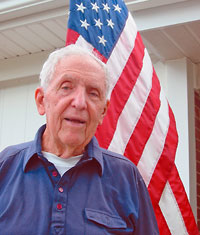Seymour Johnson in '42 'not much more than a farm,' says visitor
By Matt Shaw
Published in News on October 4, 2004 2:01 PM
When Maurice Snyder first came to Goldsboro, some of the best barbecue was served at En-Cee-Cue. Center Street was alive at night with servicemen hitting favorite watering holes.
The "hottest" night spot was the USO Club at the corner of William and Mulberry streets. In those days, they didn't have air conditioning, so the club's windows were left open to cool the standing-room-only crowd. The music could be heard for blocks around.

News-Argus/Matt Shaw
Maurice Snyder
Seymour Johnson Field was little more than a runway and buildings under construction when Snyder first saw it. "It really wasn't much more than a farm," he said.
When Snyder arrived back in Goldsboro on Friday, 62 years later, things had changed. That barbecue restaurant is gone, replaced by a dry cleaners, and the USO Club is now the Wayne County Museum.
And Seymour Johnson Air Force Base is one of the highest regarded U.S. military installations.
"Look at it today -- it's an elite field," he said. "It makes me proud, knowing what it once was."
Snyder, 90, was stationed at Seymour Johnson from May 1942, weeks before the field officially opened, until May 1944. The Williamsport, Md., resident was back in town this weekend for a family reunion.
He had enlisted in the Army to serve a year of mandatory service and was near completion at a post in San Antonio, Texas, when the Japanese bombed Pearl Harbor on Dec. 7, 1941. The military extended his service.
In early 1942, the Army Air Force began offering transfers. "I thought that might be a little better than walking all the time," Snyder said with a laugh.
When he got to Goldsboro, many of the field's buildings were still little more than foundations. The servicemen bunked on the floor of William Street School. Headquarters was set up temporarily at the County Courthouse.
At the time, the airfield was two miles southeast of the city limits and the area around it was wet.
"We saw mosquitoes that summer that we thought might carry us away," he said.
Only a few hundred men were initially assigned to Seymour Johnson, which had been established as a technical school to train mechanics and others. But within weeks, a trainload of men came from Chanute Field in Illinois, bumping the base's enlisted numbers over 2,000.
Snyder worked in personnel, so he was busy with the newcomers, making sure they had all necessary immunizations and credentials.
The base took on other missions during Snyder's tenure. In June 1943, it began preparing officers and men for overseas duty, and then in September, it began to provide basic military training for cadets preparing to become technical officers in the Army Air Corps. In 1944, basic training of P-47 pilots became the field's primary mission.
During this time, Goldsboro welcomed its newcomers, he said. Mayor Scott Berkeley and the Chamber of Commerce organized outings for the servicemen, Snyder said. Many families invited them into their homes for meals, and churches also made special outreach efforts.
It was at a free dinner offered by First Baptist Church that Snyder met his wife, the former Edna Cooper.
Decades have passed since then. Snyder was transferred to Boca Raton, Fla., in 1944 and finally Naples, Italy, before his service ended in 1945. He went back home to Williamsport where he returned to his previous place of employment, a leather and tanning business. He retired in 1980 as vice president of sales. He has been a widower for a decade.
Throughout it all, Snyder has carried strong memories of his time here.
"The people of Goldsboro were very gracious to all of us who were strangers in their community," he said. "I will never forget their kindness."
